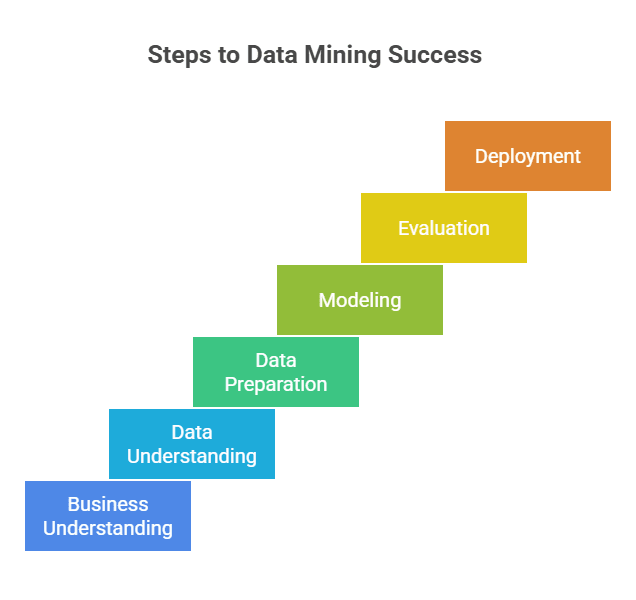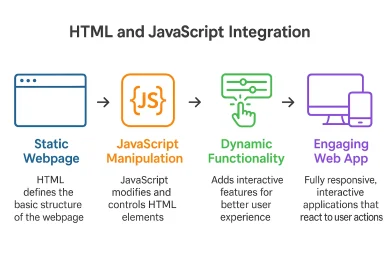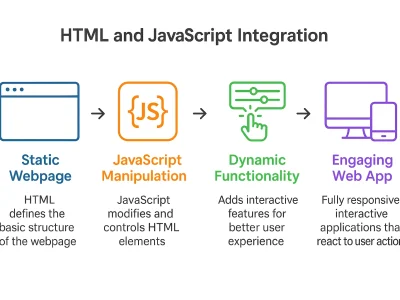Introduction to Data Mining
Today, businesses and organisations generate and handle large amounts of data. However, handling raw data has no value until it is analysed and insight into its value to transform it into actionable data. Data mining is the process of analysing, processing and extracting meaningful data from the massive datasets with the help of Machine learning, Artificial Intelligence and statistical AI techniques. This process is a powerful technique to uncover patterns, trends and relationships with large datasets. Data Mining converts raw data into valuable insights involving steps such as Data Collection, Cleaning, Integration, Selection, Transformation, Pattern Discovery, Evaluation and Interpretation. This technique specifies that the raw data is processed to extract valuable information.
Data Mining and Machine learning look familiar but perform different functions. Data Mining primarily focuses on analysing and finding data for the recent trends and patterns within data, which depends on human intervention to specify the scope and parameters. However, Machine learning involves making predictions and decisions from the data without any explicit programming. Thus, Data Mining helps in extracting information, whereas Machine learning uses analyzed data for predictions and the decision-making process.
Data Mining is essential in this modern digital age, as it supports making informed decisions, predicting market trends prediction and extracting meaningful trends from large datasets. The key aspects of application involve Business Intelligence, Customer Relationship Management (CRM), Risk Assessment, Scientific research and predictive analytics.
How Data Mining Works
Data Mining works by transforming unstructured data into valuable knowledge that drives the decision making process. Let’s explore on a journey through the key steps of data mining, CRISP-DM Framework, Pattern Identification and Predictions making.

Key Steps in Data Mining
The Data Mining process is constant and involves the following steps
- Data collection: It assembles useful data from variable resources.
- Data Cleaning: It discards unwanted data and unclutters it to ensure quality.
- Data Integration: It associates data from different resources into united data.
- Data Selection and Transformation: It selects significant data and transforms it into a convenient layout.
- Pattern Discovery: It uses algorithmic techniques to identify valuable patterns and relationships.
- Evaluation and Interpretation: It evaluates the trends in order to get valuable and required information.
CRISP-DM Framework: A Standard Approach to Data Mining
The Cross-Industry Standard Process for Data Mining (CRISP-DM) is a commonly used approach for outlining the stages of a data mining project.
- Business Understanding: This step defines the objectives and requirements from a business. It helps to identify key challenges and determine success criteria. Customer requirements, Market conditions and Business limitations are determined to define specific requirements that streamline data selection and modeling for significant and useful insights.
- Data Understanding: Here, the selected data is analysed to become informed by the activities that include collecting data, data analysis exploration and data quality assessment. This stage ensures that the data is appropriate for solving the required business problem.
- Data Preparation: This stage is the most time consuming phase which involves selecting relevant data to clean it and creating the required data formats to integrate it into various datasets. The objective of this phase is to finalise the prepared dataset for modeling.
- Modeling: Several modeling techniques are chosen and used to prepare the data. This is a periodical process that involves constructing various models to find the best representation of the data patterns
- Evaluation: Here the created models and patterns are evaluated to make sure that they meet the required business objectives. It ensures the robustness and accuracy of the model. It also determines whether the data model is suitable for deployment or any additional refinement is needed.
- Deployment: The evaluated and finalized models are implemented into real world operation in this final phase. This process includes report generation, model integration for decision making process and predictive analytics system for development.
This CRISP-DM framework iterative model ensures flexibility and adaptation for reviewing earlier phases as and when needed.
Identifying Patterns and Making Predictions
Pattern recognition and predictive modelling are the main core of the data mining process. Here, a group of similar data points are clustered and classified to assign it to predefined categories. Knowing association rules helps to identify relationships between variables widely used in the market basket analysis. Thus, identifying patterns and models helps the business to enable tasks such as spam detection, customer segmentation, and identification of frequently purchased products in the market.
Regression analysis is the important technique used in making predictions. With the analysis of historical data, this regression model assists in predicting future trends and strategic planning for the business. For example, retailers use regression techniques to forecast sales based on seasonality and marketing efforts.
To practically apply these data mining techniques using Python or R, you can explore this Data Science course by Tutedude that covers real-world projects and ML foundations.
Major Benefits of Data Mining
Data mining provides various benefits by transforming various datasets into valuable insights to help businesses. Some of the advantages are as follows.
- Data driven Decision for Business growth analyzes historical trends to calculate demand, price optimization and marketing refinement for sustainable growth.
- Fraud Detection and Security Threat Mitigation helps to detect suspicious activities in cybersecurity, monitoring compliance, financial transactions to prevent fraud and mitigate risks.
- Enhancing Personalization and Customer Experience Optimization helps to improve customer engagement and offer personalized services through recommendations and boosting satisfaction.
- Operational efficiency enhancement streamlines supply chain management, HR analytics and workforce planning. This helps to improve organizations productivity with reduced costs.
Top Data Mining Techniques
Data Mining employs several techniques to extract meaningful information from large datasets. Some of the them are as follows
Classification and Clustering
Classification: In Decision Tree algorithm, data are categorized with decision rules based on input features For instance, decision trees categorize patients having a high or low risk disease according to their symptoms, age and lifestyle.
Clustering: This learning technique uses K-Means where identical data points are grouped together and divided into clusters. For instance, Retailers use clustering techniques to classify customers based on purchasing patterns which helps to target marketing strategies.
Association Rule Mining
This technique exposes some of the notable relationships among the variables in large datasets by analysing hidden data patterns. Market Analysis helps to identify the products frequently purchased together. Retailers use this information to organize store layouts or combo deals designing tactics.
Regression Analysis and Predictive Modeling
Based on the historical data, this technique enables predictions of future outcomes. Businesses employ these techniques to divide marketing budgets based on advertising costs. Predictive modeling creates models that predict forecasting trends and outcomes such as customer churn to achieve proactive retention strategies.
Neural Networks and Deep Learning
Deep learning techniques use neural networks to analyze large datasets that involve speech and image recognition. This approach helps in a smarter Decision-Making process. Chatbot queries and personalised content recommendations are automated using these techniques for better customer engagement.
Anomaly Detection and Text Mining
Anomaly Detection: This method categorizes the irregular data points from the datasets to detect fraudulent activities or system malfunctions. For instance, banks monitor transaction patterns to identify unusual behaviour that indicates fraud.
Text Mining: This process extracts useful information from the textual data. It analyses customer reviews, social media posts or support tickets to gain information for the emerging trends and areas needing improvement, product development and customer service strategies.
Real-World Applications of Data Mining
Some of the Data mining applications in real-time usage are as follows:
Marketing and Customer Analytics
Marketing and Customer Analytics uses data mining processes to improve customer engagement through personalized recommendation. Netflix and Amazon use these analytics to identify customer behavior for tailored product and content recommendations. Based on shared characteristics, customer segmentation enables targeted advertising that matches with the specific audiences. Social media Sentiment Analysis evaluates emotions expressed in online conversation to adjust marketing strategies accordingly.
Healthcare and Medicine
Data Mining helps to analyze patterns indicative of diseases. This AI powered analysis allows personalization of treatment plans at an earlier stage. Potential therapeutic compounds are identified from the vast datasets. This reduces the development time and costs for drug discovery. Effective healthcare delivery is achieved by clinical decision making through data mining.
Finance and Banking
Fraud Detection is identified by irregular data patterns that mitigate risks. It facilitates risk assessment by predicting potential financial risks based on historical data. By analysing payment history and economic trends, data mining helps to identify credit scoring and loan predictions. This enhances the lending practices and financial stability.
Retail and E-commerce
Enhancing inventory management through Data Mining empowers retail and E-commerce businesses. This helps to predict demand forecasting techniques in sales. Dynamic pricing strategies analyze real time data analysis to fix the product prices based on customer behavior, market demand and increased profitability. Identification of Purchasing patterns and preferences through Data mining helps in customer retention.
CyberSecurity
Data Mining enables network traffic anomaly detection and boosting threat intelligence efforts to enhance cybersecurity. Data Mining also uncovers emerging threats and informs proactive defence strategies.
Supply Chain and Logistics
Delivery Delay predictions and route optimization are enabled accurately by enhancing supply chain and logistics operations through the Data Mining process. In Warehouse and Inventory Management, data mining predicts demand forecasting to maintain optimal stock levels and reduce holding costs. This prevents overstock or stockout situations in the future.
Challenges and Limitations in Data Mining
Data Mining has various benefits but still faces several challenges. Some of them are as follows.
- Due to the improper handling of personal information, It is critical to ensure data privacy and compliance with regulations like GDPR and CCPA.
- Advanced tools are required to process diverse data formats to handle large and unstructured Data sets.
- Accuracy in predictive models is vital as biases can result in poor decisions.
- Computational costs with large datasets need efficient algorithms and infrastructure which results in resource constraints.
Future of Data Mining : What’s Next?
The future of Data Mining is a transformative advance. AI powered automation through Automated Machine Learning (AutoML) makes advanced analytics more accessible. Integration of Edge computing with Data Mining process enables real time analytics. This reduces the latency to enhance responsiveness. The importance of Ethical AI and responsible Data Mining practices ensures the data driven decisions are transparent with evolving regulations. This collectively promises an efficient data mining process.
Final Thoughts
Data mining is more than just a technical process- it’s a key driver of business intelligence and innovation. As industries continue to embrace AI and big data, mastering data mining techniques will be essential for staying ahead in the digital world.




